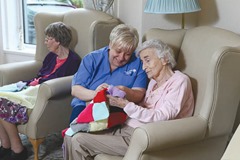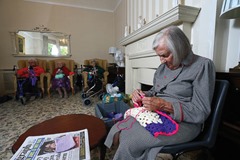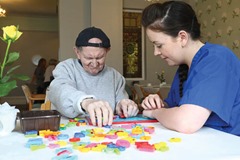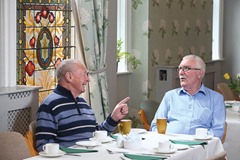A care home at work
 Peter Cheney visits Adelaide House to find out how its staff are helping residents to live full and healthy lives in their later years.
Peter Cheney visits Adelaide House to find out how its staff are helping residents to live full and healthy lives in their later years.
The warmth of welcome and the well-maintained building and grounds point to a high quality of care at Adelaide House. While the public’s impression of a care home is often a place of stillness, this South Belfast residential home is a hive of activity – all with the aim of keeping its residents healthy.
Acting manager Norma Picking explains: “We try to empower them here to be as independent as they can possibly be but we’re always here in the background to help.”
The knitting club makes blankets which are sent out to families in Africa. Come Dine With Me, Strictly Come Dancing and I’m a Celebrity Get Me Out of Here are all part of the repertoire. To simulate the last show, five residents are blindfolded and given mystery foods to taste – like mustard and jelly. Staff also take residents down to the Lisburn Road for coffee or a visit to the shops.
Adelaide House is one of six residential homes run by the Presbyterian Church’s Board of Social Witness. In late 1940s, Rev William Corkey felt that there was a need for accommodation for older women. He helped to acquire a semi-detached house (opened in 1950) which was later expanded into the property next door. Another section – the Corkey wing – was added in 1989.
 The building is now home to 44 residents and 35 staff are employed. It branches out and around a garden and stained glass windows add extra colour and detail to the surroundings.
The building is now home to 44 residents and 35 staff are employed. It branches out and around a garden and stained glass windows add extra colour and detail to the surroundings.
“For older people, they like to have that little bit of character in the building as well,” Linda Wray, the board’s Residential Services Manager, comments. Its Christian ethos includes 10-15 minutes of devotional time each morning, led alternately by staff, residents and local ministers. Residents come from a variety of faiths (or none) and value the support that the home provides.
“This isn’t coming to work for me,” Norma quips. “And there’s not many people can say that.” She emphasises: “This is their home. It’s not ours.” Staff, for example, ask residents when they would like to be bathed or showered and “we do what they want within reason as long as it wouldn’t risk their health.” When a resident passes away, it is like losing a member of the family: “It’s a privilege for us if we can keep them to the end of their life because we will be there with them.”
The rising amount of paperwork is a difficulty although it is important to have all documentation ready for inspections. In addition, Linda Wray pays unannounced visits during which she talks with staff, residents and visitors and generally looks at the home with a fresh pair of eyes. She is sometimes accompanied by members of the home’s local support committee – drawn from nearby congregations – who also help out with Adelaide House’s activities.
Eight of the home’s beds are for people with dementia, and the staff try to get to know them, their life story and their families.
“We had one wee lady and she loved her garden, and every night she wouldn’t settle,” Norma recalls. The resident’s husband had bought her three model rabbits for their garden several years ago. The family brought those into the home’s garden and she settled down right away.
All staff have mandatory training in first aid, moving and handling and safeguarding. Several staff in each Board of Social Witness home receive training as ‘dementia facilitators’ through the University of Stirling and can therefore make other staff aware of the specific needs of people with dementia.
Dependency
“Individuals, as they come into a residential home, are much more dependent than they would have been previously,” Linda comments. Twenty years ago, Adelaide House was viewed as more of a retirement home with residents having their own cars parked outside and going out on their own to socialise. The last decade has seen a major increase in the number of people who are more dependent. As the Transforming Your Care policy aims to help people to live at home as long as possible, they generally only enter homes when they become frailer.
Each year, the home takes a group of residents to a local primary school where they talk about their experience of the Second World War. Linda Wray explains: “When the children finish the projects, the residents actually mark the projects and the kids come and spend the day here.” They arrive dressed as evacuees and have a quiz and sing-along with the residents. This is appreciated by the residents and it also teaches the children about respect for older people and life in a care home.
Separately, younger members of staff have learnt lessons from residents about bringing up their own children. “When you’re working with them every day and talking to them, they’ve a wealth of wisdom and they don’t even know it,” Norma remarks.
John McNally
A sprightly 81-year old, John McNally (pictured right) won a silver medal for Ireland as a bantamweight boxer at the 1952 Helsinki Olympics. The next year, he took part in the Golden Gloves in the USA before going on to train and work as a mechanical engineer. “Nobody bothers me and we try to do our bit,” he quips as he sits with his friend, Ernie Nutt (84). He regularly gets the bus into the city centre and meets up each week with fellow Olympian Hugh Russell. “I hope so,” John says when commended for being fit and well. “I have to be to keep up with this critter.” Ernie quips: “He should be a good tennis player, you know, because he’s in all the rackets.”
Ernie Nutt, also a retired engineer, tends the home’s garden. “They look after us very, very well,” he says of the staff. For him, an apprenticeship in the Sirocco works led to 14 years working in the South African mines. “I really loved it,” he recalls. “It was just like walking down that passageway … The only thing you couldn’t have was a cigarette.”
In a special bond within the home, Ernie also cares for his mum, Eileen, who at the age of 104 is its oldest resident. Mrs Nutt still has a good appetite. “She kept me for 25 years at home,” Ernie remarks, “so why shouldn’t I look after her now?”








